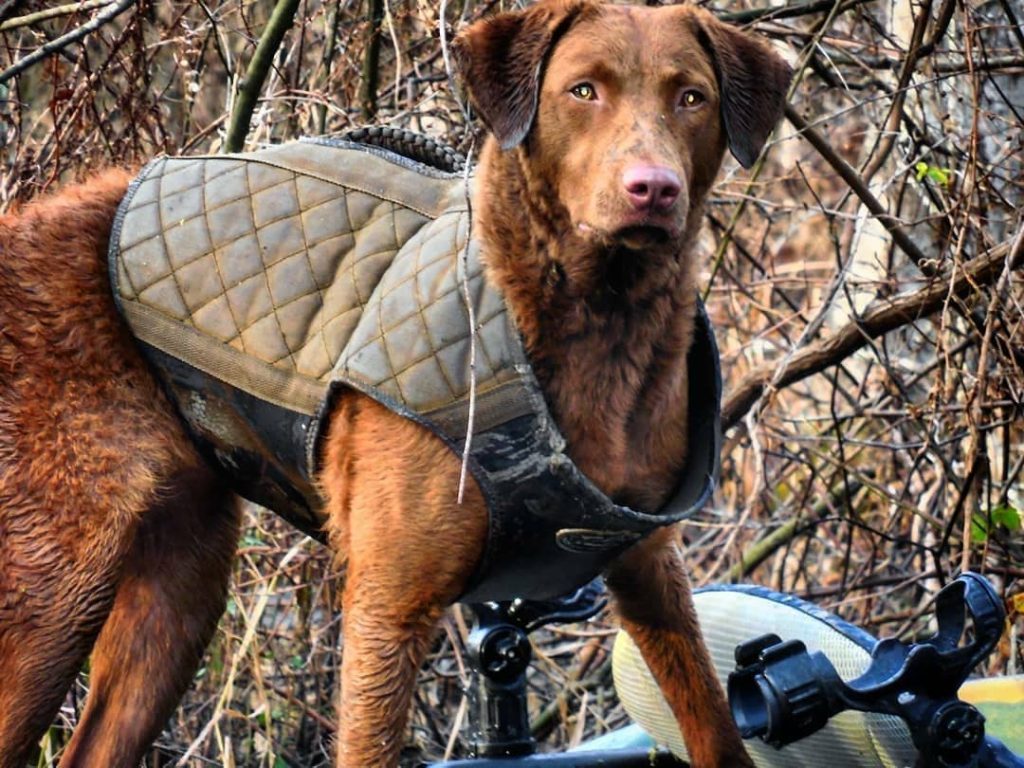
The Chesapeake Bay Retriever, affectionately known as the Chessie, is a testament to American ingenuity and resilience in dog breeding. Developed in the United States, specifically around the Chesapeake Bay, these retrievers are renowned for their strength, intelligence, and versatility. Originally bred to retrieve waterfowl in harsh and icy conditions, they are hardworking and display an admirable level of endurance and determination, characteristic of the Chesapeake Bay Retriever dog breed.
This breed’s unique combination of physical robustness and mental acuity makes them an excellent choice for various roles, extending beyond hunting to activities such as search and rescue, therapy, and companionship. Their loyalty and protective nature make them an ideal family pet, especially for Chesapeake Bay Retriever owners who lead an active lifestyle and can provide the level of exercise and engagement these dogs thrive on.
Understanding the Chesapeake Bay Retriever requires a deep dive into their origins, physical and behavioral characteristics, and specific training and care needs. This comprehensive guide aims to provide potential owners, trainers, and canine enthusiasts with essential insights into raising a well-adjusted and healthy Chessie, ensuring that this remarkable hunting dog breed thrives and brings joy to their human companions.
Retriever Breed Origins and History
Development of the Breed
The Chesapeake Bay Retriever’s story is a fascinating blend of history and legend intertwined with the development of America’s eastern seaboard. The breed’s origins date back to the early 19th century, anchored in a tale of two Newfoundland puppies, named “Sailor” and “Canton,” who were reportedly rescued from a foundering ship off the coast of Maryland. These puppies, each exhibiting exceptional retrieving abilities and a love for water, became the foundation for the Chesapeake Bay Retriever breed, known for its prowess as a hunting dog.
Local waterfowl hunters quickly recognized the potential of these dogs for retrieving ducks and geese in the challenging conditions of the Chesapeake Bay. The icy waters and rugged terrain necessitated a dog that was not only a skilled swimmer but also capable of enduring the harsh, cold environment. The breeders focused on these traits, selectively breeding for a strong, robust dog with a dense, waterproof coat and an unparalleled retrieval ability, characteristics that have made Chesapeakes indispensable for hunters in the region.
As the breed developed, its reputation spread. The Chessie became known for its remarkable sense of smell, intelligence, and distinctive coat, which ranged in color from dark brown to a sedge and dead grass hue, providing camouflage in the hunting environment. This coat is one of the Chesapeakes most distinctive features, with its double-layered texture providing insulation and water resistance.
The development of the Chesapeake Bay Retriever is a testament to the breed’s adaptability and resilience. Combined with their unique history, these traits have endeared the Chessie to generations of dog owners, from hunters and fishermen to families looking for a loyal pet.

Characteristics of Chesapeake Bay Retrievers
Physical Attributes
The Chesapeake Bay Retriever is a robust and muscular dog known for its distinctive water-resistant double coat, ranging from dark brown to sedge and dead grass hues. They typically weigh 55 to 80 pounds and stand about 21 to 26 inches tall at the shoulder. Their broad chest, strong limbs, and webbed feet make them powerful swimmers, adept at navigating challenging aquatic environments.
Behavioral Temperament
Chessies are renowned for their intelligence, loyalty, and protective nature. They are often reserved with strangers but deeply devoted to their families. This breed thrives on physical activity and mental challenges, making them ideal for active households. They can be independent and strong-willed, thus requiring consistent training and socialization from a young age.
Training Your Chesapeakes Bay Retriever Essentials
Basic Training Techniques
- Consistency is Key: Chesapeake Bay Retrievers respond best to consistent training methods. Regular practice and reinforcement of commands are crucial.
- Positive Reinforcement: Utilize treats and praises to encourage desired behaviors. Chessies are food-motivated, making this a highly effective approach.
- Start Early: Begin training when they are puppies. This sets a foundation for more complex training in the future.
- Leash Training: Teach them to walk on a leash without pulling. This is important for their safety and the comfort of the handler.
- Basic Commands: Focus on essential commands like ‘sit,’ ‘stay,’ ‘come,’ and ‘heel.’ These form the basis of obedience training.
Advanced Training Concepts
- Retrieval Training: As natural retrievers, training them to fetch and return objects can be a fun and helpful activity.
- Water Training: Introduce them to water early, as they excel in swimming and water-based activities.
- Agility Training: Chessies are agile and can benefit from courses challenging their physical and mental capabilities.
- Problem-Solving Skills: Engage them in activities that require them to think, like hide and seek with treats or toys.
Socialization and Interaction Hunting Dog
- Early Socialization: Expose them to different people, environments, and other animals early to develop well-rounded social skills.
- Structured Playtime: Organize playdates with other dogs, ensuring controlled and positive interactions.
- Behavioral Boundaries: Teach them appropriate behaviors when interacting with people and other pets, like not jumping or being overly possessive.

Health and Care for Chesapeake Bay Retrievers
Chesapeake Bay Retrievers are generally robust dogs, but like all breeds, they have specific health and care needs to ensure they lead a long and happy life. Regular veterinary check-ups, a balanced diet, and adequate exercise are fundamental to maintaining health. Chessies are known for their dense, oily coat, which requires regular grooming to keep it in good condition and minimize shedding.
Grooming and Health Maintenance
- Coat Care: Brush their coat weekly to remove loose hair and distribute natural oils.
- Ear Care: Regularly check and clean their ears to prevent infections, especially since they are prone to ear issues.
- Dental Hygiene: Brush their teeth several times weekly to prevent tartar buildup and gum disease.
- Exercise: Daily exercise keeps them physically fit and mentally stimulated.
- Regular Vet Visits: Annual health check-ups and vaccinations are crucial for early detection and prevention of health issues.
- Hip and Joint Health: Monitor their hip and joint health, as they can be prone to conditions like hip dysplasia.
Nutritional Needs and Diet
The nutritional needs of a Chesapeake Bay Retriever vary depending on their age, size, and activity level. A protein-rich diet is essential for muscle maintenance, particularly for active Chessies. Monitoring their food intake is vital to prevent obesity, which can lead to health problems. Always provide clean, fresh water, especially since they spend a lot of time active.
In conclusion, caring for a Chesapeake Bay Retriever requires a commitment to regular grooming, health monitoring, and providing a balanced diet. These dogs can be joyful and healthy companions with proper care for many years.
Suitable Home Environments for Chesapeake Bay Retrievers
Chesapeake Bay Retrievers are adaptable dogs, capable of thriving in various home environments, provided their needs for exercise, companionship, and mental stimulation are met. They are best suited to active households that can accommodate their high energy levels and need for regular physical activity. Chessies form strong bonds with their families and protect their homes and loved ones.
Creating a Chessie-Friendly Home
- Space for Exercise: Access to a yard or nearby parks for regular exercise is ideal.
- Family Involvement: They flourish in environments where they are included in family activities.
- Pet Compatibility: Introduce Chessies to other pets early, as they can be dominant but generally get along well with other animals if socialized properly.
- Mental Stimulation: Provide toys and activities that challenge their intelligence.
- Safe Swimming Opportunities: Given their love for water, access to safe swimming areas is a bonus.
- Routine and Structure: Chessies respond well to a structured routine, which helps manage their energy and behavior.
While Chesapeake Bay Retrievers are versatile and can adapt to different living situations, they must be better-suited to being left alone for long periods. They require regular interaction and mental engagement to prevent boredom and the development of destructive behaviors. Prospective owners should be prepared to invest time and energy into training, exercising, and caring for these active and intelligent dogs. A Chessie’s ideal home is one where they can be an integral part of daily life, receiving the love and attention they thrive on. Understanding the Chesapeake Bay Retriever’s breed profile is essential for ensuring a harmonious relationship between the dog and its owner.
Recreational Activities and Sports for Hunting Dog

With their robust build and high energy levels, Chesapeake Bay Retrievers are natural athletes and excel in various recreational activities and sports.
Water-Based Activities
Their inherent love for water makes them particularly adept at water-based activities. Swimming is not just an enjoyable pastime for Chessies; it’s also an excellent way for them to expend energy and stay fit. Many owners involve their Chessies in dog sports like dock diving, where dogs leap from a dock into the water to retrieve an object. This activity capitalizes on the breed’s natural retrieving instincts and love of water.
Outdoor Adventures
In addition to water sports, Chesapeake Bay Retrievers thrive in outdoor adventures. They are excellent hiking companions, able to handle various terrains with ease. Their endurance and agility make them well-suited for trail running and camping trips. Chessies often excel in agility and obedience trials for those interested in competitive sports, showcasing their intelligence and trainability.
It’s important to remember that engaging a Chesapeake Bay Retriever in these activities helps maintain their physical health and provides mental stimulation, which is crucial for this intelligent breed. These activities strengthen the bond between the dog and its owner and provide an outlet for Chesapeake Bay Retrievers’ abundant energy and natural abilities, making them excellent family dogs.
Conclusion and Summary for Dog Owners
In conclusion, the Chesapeake Bay Retriever is a remarkable breed known for its strength, intelligence, and versatility. From their origins as skilled waterfowl retrievers to their roles as family companions, Chesapeake Bay Retriever puppies have proven to be loyal, energetic, and capable dogs. Proper training, socialization, and care are essential in bringing out the best in these dogs, ensuring they lead a balanced and fulfilling life. Whether engaging in water sports, enjoying outdoor adventures, or simply being a devoted member of the family, the Chesapeake Bay Retriever is a breed that commands admiration and offers a deep bond to those who understand and meet their needs. With the right environment and commitment, a Chessie can be not just a pet but a true partner in life’s adventures.
